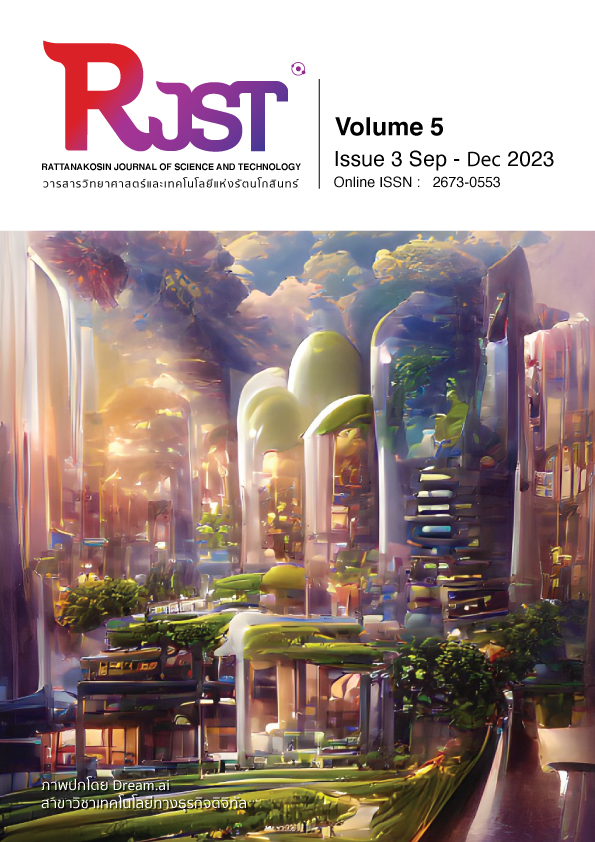Temperature effects on a mixture of recycled asphalt concrete pavement and lateral soil
Main Article Content
Abstract
Reclaimed Asphalt Pavement (RAP), widely used by mixing with other material for road structure material or Asphalt Hot – Mix Recycling, is the reuse of old asphalt concretes that was removed by milling machines. RAP contains two elements of asphalt and aggregates that can’t be used directly for road structure work without mixing or adding with another material due to it have no ability to densify by conventional compaction technique. This research focusses on how to use RAP as a backfill material without the pavement on the top of surface which the compacted material directly receives the solar heat. The results show that the appropriate mix proportion of laterite soil and RAP improves the engineering properties of RAP in both room and ambient temperature of 60 degrees. This research also presents the method to fine the appropriate mix proportion of both material in term of engineering properties and construction cost.
Article Details

This work is licensed under a Creative Commons Attribution-NonCommercial-NoDerivatives 4.0 International License.
The content within the published articles, including images and tables, is copyrighted by Rajamangala University of Technology Rattanakosin. Any use of the article's content, text, ideas, images, or tables for commercial purposes in various formats requires permission from the journal's editorial board.
Rajamangala University of Technology Rattanakosin permits the use and dissemination of article files under the condition that proper attribution to the journal is provided and the content is not used for commercial purposes.
The opinions and views expressed in the articles are solely those of the respective authors and are not associated with Rajamangala University of Technology Rattanakosin or other faculty members in the university. The authors bear full responsibility for the content of their articles, including any errors, and are responsible for the content and editorial review. The editorial board is not responsible for the content or views expressed in the articles.
References
กรมโยธาธิการและผังเมือง กระทรวงมหาดไทย. (2557). มาตรฐานงานทาง.
กรมทางหลวง. (2544). มาตรฐานที่ ทล.-ม.201/2544. มาตรฐานพื้นทางหินคลุก.
กรมทางหลวง. (2532). มาตรฐานที่ ทล.-ม. 205/2532. มาตรฐานรองพื้นทางวัสดุมวลรวม.
กรมทางหลวง. (2532). มาตรฐานที่ ทล.-ม. 208/2532. มาตรฐานวัสดุคัดเลือก ก.
Mohod, M. V. and Kadam, K. N. (2016). A comparative study on rigid and flexible pavement: A review. IOSR Journal of Mechanical and Civil Engineering (IOSR-JMCE), 13(3), 84-88.
Arvo Tinni. (2013). Introduction to Concrete Pavements ii, Introduction to Concrete Pavements, EestiBetooniühing.
กรมทางหลวง. (2543). มาตรฐานที่ ทล.-ม.213/2543. การหมุนเวียนวัสดุชั้นทางเดิมมาใช้งานใหม่ (Pavement Recycling).
พงศา ไวยากรณ์, จิระยุทธ สืบสุข, อนิรุทธิ สุขแสน, อัครเดช ศิริพันธุ์ และ หวังแก้ว บุญสวน. (2560). การเปลี่ยนแปลงอุณหภูมิและพฤติกรรมทางกลของชั้นพื้นทางหินคลุกผสมซีเมนต์ทีได้จากกระบวนการหมุนเวียนวัสดุชั้นทางเดิมมาใช้งานใหม่ภายใต้การใช้งานในภูมิภาคเขตร้อน การประชุมวิชาการวิศวกรรมโยธาแห่งชาติ ครั้งที่ 22.
กรมโยธาธิการและผังเมือง. (2557). มาตรฐานที่ มยผ. 2102/57. มาตรฐานวัสดุรองพื้นทาง (Subbase).
กรมทางหลวงชนบท. (2545). มาตรฐานที่ มทช.202-2545. มาตรฐานวัสดุรองพื้นทาง (Subbase)


